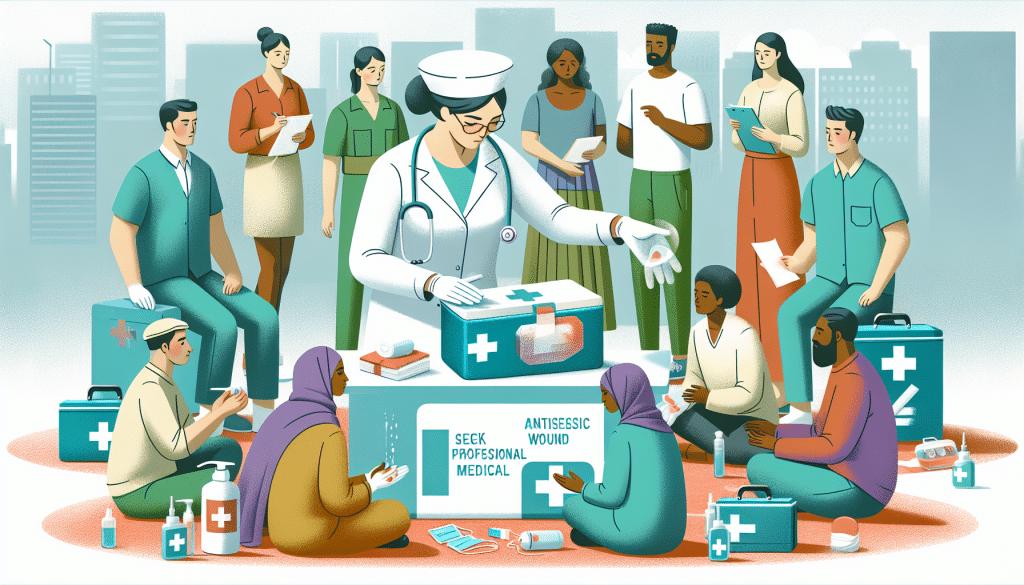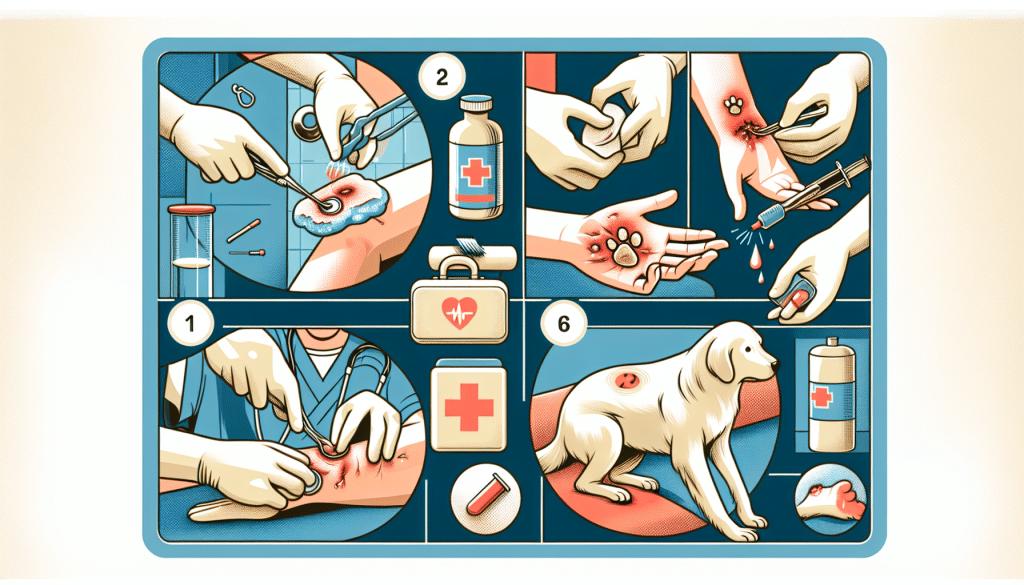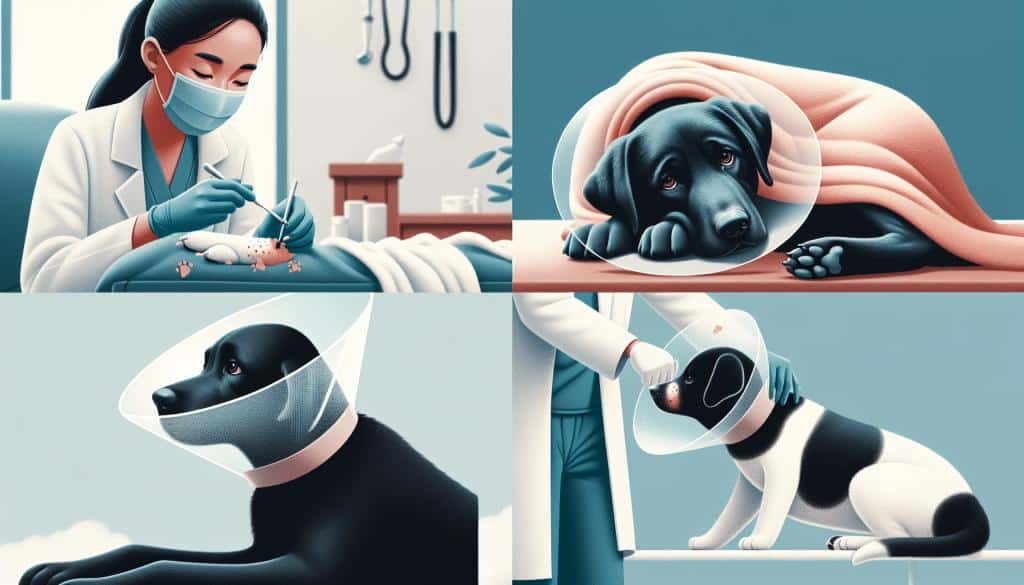So you’re out for a leisurely stroll in the neighborhood when, unexpectedly, a furry friend dashes towards you and sinks its teeth into your leg. Panic sets in, but fear not! In this article, we’ll provide you with essential knowledge on how to handle a dog bite and administer proper first aid. From cleaning and dressing the wound to recognizing potential infection, we’ve got your back (or leg) covered when dealing with this not-so-friendly encounter.

Understanding Dog Bites
When it comes to understanding dog bites, it is crucial to be able to identify them. A dog bite is a puncture or laceration caused by a dog’s teeth, and it can vary in severity. Dog bites can occur anywhere on the body, but commonly affect the hands, arms, and face. It is important to be able to differentiate between a dog bite and other types of wounds in order to provide appropriate treatment.
Dog bites can pose potential dangers, both physically and emotionally. Physically, a dog bite can lead to infection, nerve damage, and severe tissue damage. In some cases, dog bites can even be life-threatening, especially if they occur in certain areas of the body or if the dog is carrying diseases such as rabies. Emotionally, dog bites can lead to fear, anxiety, and even post-traumatic stress disorder. Understanding these dangers can help emphasize the importance of taking immediate action after a dog bite occurs.
So, why do dogs bite? Dogs may bite due to various reasons, including fear, pain, territorial aggression, possessiveness, or even playfulness. It is essential to remember that each dog is an individual, and their behavior can be influenced by their upbringing, training, and environment. Additionally, dogs may exhibit warning signs before biting, such as growling, showing their teeth, or stiffening their body. Recognizing these signs and understanding the underlying reasons can help prevent dog bites from happening in the first place.
Immediate Action Against Dog Bites
When faced with a dog bite, it is crucial to take immediate action in order to minimize the risk of infection and further damage. The first step is to wash the wound thoroughly with soap and warm water for at least five minutes. This helps remove any dirt or bacteria that may be present in the wound. After washing, apply an antiseptic solution or hydrogen peroxide to disinfect the area.
Remaining calm is of utmost importance. As tempting as it may be to panic or become aggressive, it is crucial to stay composed. Dogs can sense fear and agitation, which may escalate the situation further. By remaining calm, you can help prevent the dog from becoming more aggressive or frightened.
If possible and safe to do so, remove yourself from the situation. Slowly and calmly create distance between you and the dog. Do not turn your back on the dog or make any sudden movements that could trigger another attack. It is important to prioritize your safety and remove yourself from any immediate danger.

Wound Assessment
After the initial action against a dog bite, it is essential to assess the severity of the wound. Superficial wounds may include scratches or shallow punctures, while deeper wounds may involve more significant tissue damage. Assessing the severity of the wound can help determine the appropriate course of treatment and whether medical attention is necessary.
There are several types of wounds that can result from dog bites. Puncture wounds are narrow and deep, often caused by the dog’s teeth. These wounds can be difficult to clean and may require medical attention. Lacerations, on the other hand, are wider and result from tearing of the skin and underlying tissue. They may have jagged edges and can bleed profusely. Avulsion wounds occur when a portion of the skin or tissue is completely torn away. These wounds may require immediate medical attention to prevent further complications.
Recognizing signs of infection in a dog bite wound is crucial. Symptoms of infection may include redness, swelling, increasing pain, warmth around the wound, discharge of pus or fluid, and fever. If any of these signs are present, it is important to seek medical attention as soon as possible. Prompt treatment can help prevent the infection from spreading and causing further complications.
Initial Dog Bite Treatment
When it comes to treating a dog bite, starting with proper wound care is essential. Clean the wound thoroughly with mild soap and warm water, gently removing any debris or dirt that may be present. It is important to avoid the use of alcohol, hydrogen peroxide, or iodine, as these can delay wound healing. After cleaning, apply gentle pressure to the wound with a clean cloth or sterile gauze to control bleeding.
Applying a sterile bandage or dressing to the wound can help protect it from further contamination and aid in the healing process. It is important to change the bandage regularly and keep the wound clean and dry. Avoid using adhesive bandages directly on the wound, as they may irritate the skin and hinder the healing process.
In some cases, healthcare professionals may recommend the use of topical treatments such as antibiotic ointments or creams. These treatments can help prevent infection and promote healing. However, it is vital to follow the advice of a healthcare professional, as not all wounds may require topical treatments. Applying unnecessary medications can potentially lead to adverse reactions or delay the natural healing process.

Professional Medical Attention
While many dog bites can be treated at home, there are situations that require immediate medical attention. If the wound is deep, wide, or involves severe tissue damage, it is recommended to seek professional medical help. Additionally, dog bites on the face, hands, feet, or genital area often warrant medical attention, as they can have serious implications for function and appearance.
In many cases, it is also advisable to report a dog bite to the appropriate authorities. This is especially important if the dog is unknown or if the bite occurred in a public place. Reporting a dog bite can help prevent further incidents and protect others from potential harm. Contact your local animal control or health department to inquire about reporting procedures and requirements.
Post-bite check-ups are essential, even if the initial wound seems to be healing well. By seeking follow-up care, healthcare professionals can assess the progress of the wound, monitor for signs of infection or complications, and provide additional treatment if necessary. Regular check-ups can help ensure proper healing and minimize the risk of long-term complications.
Dog Bite Prevention
Preventing dog bites starts with understanding dog behavior. Being aware of the warning signs that a dog may exhibit before biting can help individuals avoid potentially dangerous situations. These signs may include growling, barking, showing teeth, or stiffening of the body. Paying attention to a dog’s body language can provide valuable cues about its comfort level and potential aggression.
Educating children about dog bite prevention is crucial, as they are particularly vulnerable to dog bites. Teach children to ask for permission from a dog’s owner before approaching, and to avoid approaching unfamiliar dogs without adult supervision. Encourage children to be gentle and cautious around dogs, and to never disturb a dog that is eating, sleeping, or caring for puppies.
Training and socializing your dog is an essential step in preventing dog bites. Enroll your dog in obedience classes to teach them proper behavior and basic commands. Positive reinforcement techniques can be highly effective in training dogs and ensuring they understand appropriate behavior around humans and other animals. Socializing your dog from a young age can also help them become comfortable and confident in various situations, reducing the likelihood of aggressive behavior.
Tetanus Risk and Management
Understanding the threat of tetanus is crucial when dealing with dog bites. Tetanus is caused by bacteria commonly found in soil and animal feces. If the dog bite involves a deep wound or if it has been more than five years since your last tetanus vaccination, it is important to seek medical attention and discuss tetanus prophylaxis with a healthcare professional.
Tetanus vaccination is recommended for individuals who have suffered a dog bite, especially if they have not received a tetanus shot within the last ten years. Tetanus shots help provide immunity against the bacteria and prevent infection and complications. It is important to discuss your vaccination history and any concerns with a healthcare professional to ensure proper management of the tetanus risk.
Symptoms of tetanus can include muscle stiffness, difficulty swallowing, muscle spasms, and fever. If you experience any of these symptoms after a dog bite, seek immediate medical attention. Tetanus is a serious and potentially life-threatening condition, and prompt treatment is crucial for the best possible outcome.
Rabies Consideration
Rabies is a viral disease that can be transmitted through dog bites. While the incidence of rabies in domesticated dogs is relatively low in many countries, it is important to consider the risk and take appropriate precautions after a dog bite. Rabies is a fatal disease that affects the central nervous system, and early intervention is vital for successful treatment.
Both dogs and humans should be up-to-date on their rabies vaccinations to minimize the risk of infection. If a dog bite occurs, it is important to contact a healthcare professional and local animal control authorities to assess the potential for rabies transmission. Depending on the situation and the dog’s vaccination status, a healthcare professional may recommend a post-exposure rabies vaccination or a period of observation for the dog.
Recognizing the symptoms of rabies is crucial. In dogs, symptoms may include behavioral changes, excessive drooling, aggression, difficulty swallowing, and paralysis. In humans, symptoms may initially resemble flu-like symptoms, but as the disease progresses, neurological symptoms such as confusion, hallucinations, and difficulty breathing may appear. If you suspect rabies in a dog or yourself, seek immediate medical attention.
Legal Implications of Dog Bites
Dog owners have a responsibility to ensure the safety of others and prevent dog bites. If you have been bitten by a dog, it is important to understand your legal rights and potential recourse. Consult a legal professional to understand the laws and regulations specific to your jurisdiction, as they can vary.
In many cases, dog owners may be held liable for the actions of their dogs. This means that they may be responsible for compensating the victim for medical expenses, lost wages, and even emotional distress resulting from the dog bite. However, it is important to gather evidence after a dog bite, such as photographs of the injuries and witness statements, to support your claim.
Understanding the local laws and regulations regarding dog ownership can also be beneficial. Familiarize yourself with leash laws, licensing requirements, and any breed-specific legislation that may be in place. By understanding these laws, you can better protect yourself and others from potential dog bite incidents.
Emotional Impact of Dog Bites
Experiencing a dog bite can have a profound emotional impact on individuals. Coping with fear and anxiety post-bite is not uncommon. It is important to acknowledge and address these emotions in order to heal both physically and emotionally.
Recognizing the signs of post-traumatic stress disorder (PTSD) is crucial, as dog bites can be traumatic events. Symptoms of PTSD may include flashbacks or intrusive thoughts about the dog bite, nightmares, hypervigilance, avoidance of situations or places associated with the bite, and changes in mood or behavior. Seeking professional psychological help when necessary is important to address these symptoms and prevent long-term psychological effects.
If you or someone you know has been affected by a dog bite, consider reaching out to a therapist or counselor experienced in trauma and anxiety. They can provide support, guidance, and coping mechanisms to help manage the emotional impact of a dog bite and work towards healing and recovery.
In conclusion, understanding dog bites is crucial for both prevention and treatment. Identifying dog bites, taking immediate action, properly assessing and treating wounds, seeking professional medical attention when necessary, preventing dog bites in the first place, managing risks such as tetanus and rabies, understanding legal implications, and addressing the emotional impact are all important aspects of dealing with dog bites effectively. By being informed and prepared, we can minimize the risks associated with dog bites and promote the safety and well-being of both humans and dogs.



